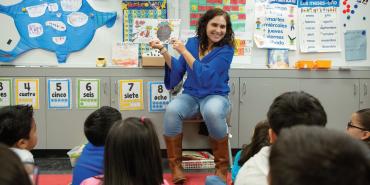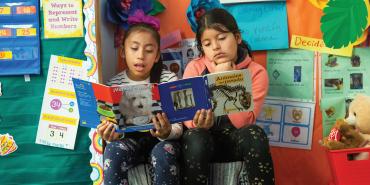Home-based language experiences and development are very important throughout childhood, so families should continue to engage in the activities described in the previous article. Once children start elementary school, it’s also important to focus on learning the letters, letter sounds, and how they combine to form words. These are the basis for reading and writing, although language development and knowledge of the world also matter.
Tips for Kindergarten
Once your child starts school, check with the teacher to see what is being taught and how you can help your child learn. You can be helpful even if your English skills are limited. Be sure to check with the teacher if you notice your child having difficulties.
Some children will be in bilingual programs, learning to read first in their home language, then in English, or in both at the same time. If they continue studying both languages throughout middle and high school, they are more likely to become bilingual and able to read and write in both languages.
Most children who speak a language other than English at home will be in English-only instruction. While encouraging your child in their school subjects, you can also help your child learn to read and write in your home language. For most families in the United States who speak a language other than English, this language is Spanish. But the same applies to speakers of other languages.
Sometimes families worry that teaching children to read and write in their home language will confuse them as they learn English. This is generally not the case. The skills children learn about reading and writing in their home language are helpful. If your child is confused, clarify that each language is valuable—and there are differences when speaking, reading, and writing in each one.
If you have taught your child the letters in their name and the sounds those letters represent, the next step is to help your child learn the names of all the letters and the sounds they represent. Use plastic letters, or blocks or cards with letters, and pictures of things that start with the letters. Have your child write letters as you provide guidance (if needed). Teach the alphabet song if your child doesn’t already know it, and point at letters as you and your child sing. As your child learns more letters, play games to practice. How many letters can your child recognize in 30 seconds? How long does it take to identify 10 letters of the alphabet? Make these into fun competitions to “beat the clock.”
As children are learning the letter names and sounds, they can also begin to learn how the letters join to form words, or as we say in Spanish, cómo se juntan las letras. This can be in the home language or English. Start with simple words, such as mamá and papá or cat and bat.
Children should also be able to identify individual sounds (phonemes) within words. This is especially important in English. Ask your child to say a word, like “cat,” and show that when you say the word—emphasize the /k/ sound when you repeat “cat”—the first sound you make is /k/. (Remember to say just the first sound, which is a crisp /k/, not /kuh/.) Then have your child say the word and tell you the first sound they make as they say the word. Do this with lots of simple words.
Another game, which is especially helpful in learning to read in English, is saying a word in pieces—sound by sound—then having your child say what the word is. For example, you say the sounds (phonemes) in the word cat: /k/, /a/, /t/. (Again, when saying the “pieces,” just make the consonant sounds, /k/ and /t/; don’t say /kuh/ and /tuh/.) Your child repeats the individual sounds, then says “cat.”
You can also go the other way: “I’ll say a word; you tell me the pieces.” Here you say “cat,” then the child says the word and breaks it down to its individual sounds: /k/, /a/, /t/. Your child might not understand right away, so demonstrate until they do and are able to play with you. It’s difficult for some children to learn, so be patient. Keep it as a fun game, not a lesson.
By kindergarten’s end, children should be able to
- write their first and last names;
- identify and write all or almost all the letters, upper- and lowercase;
- identify the sounds within words; and
- read and write simple words (e.g., run, mom, cat; or mamá, mi, mima, papá, Pepe) by thinking of their sounds and the letters.
Don’t worry about correct spelling at this point. Children will “invent” spellings for words. You can correct the spelling, but celebrate whenever the sounds and letters match (such as “fon” for “phone”).
As your child learns these skills, continue reading aloud, having conversations, and planning outings. These will build vocabulary and knowledge, which are important for literacy development.
Tips for First Through Second or Third Grades
In first grade, it is important for children to make good progress in reading words, first by sounding out words (decoding), then thinking about whether the words they read make sense. As your child reads, encourage them to look first at the letters and try to read the word; once they do that, they should ask themselves—you can remind them—does that make sense? If not, they should try again. If they’re still having trouble, you can help them sound out the word by pointing to each letter, left to right, having your child say the sound, then moving your finger quickly from left to right as you blend the sounds together. Ask your child to say the word (or say it for them, if needed), and repeat it while looking at the letters. Then your child should ask (and answer), “Does that make sense?”
As children progress in first grade and into second and even early third, they should grow more confident and accurate in sounding out words. This is easier if they’re learning to read in a language they already speak, since they will know most (if not all) of the words they’re learning to read. If they’re learning to read in a language that they’re also learning to speak and understand—English for English learners—children need to be taught the meanings of the words they’re learning to read. This way they can first read a word by sounding it out (decoding) then thinking about if they know the word and if it makes sense in context. The teacher should provide this instruction, but families can also help. If parents don’t know the meanings of English words, they should ask someone who does or use Google Translate.
As children learn to read, they should also be writing. Dictation (dictado in Spanish) is an excellent way to practice connecting the sounds of words with how words are spelled. This will also help children’s reading. Begin by dictating individual letters, then words that your child is learning to read. Gradually increase the dictations to short phrases, then sentences.
As children gain reading and writing skills, they should also be writing their own compositions, like stories or letters (with help and independently). Writing letters to relatives is an excellent way for children to show off their developing literacy skills. Children will keep inventing spellings, particularly as they’re learning to read and write in English. Family members should continue celebrating when sounds and letters match, and also show how to spell the words correctly.
It is also important for children to be learning about school subjects such as science, math, social studies, and everything else they need to learn in school. Families can help by reading and talking about the school books children bring home. They can also help by taking their children to museums, the zoo, the library, and outings to almost anywhere.
Tips for Third Through Fifth Grades
By early third grade, children should be able to sound out (decode) just about any word and learn more and more new information by reading. Reading quickly and accurately—with understanding—become even more important. Continue having your child read to you; help them read fluently and confidently, and ask questions to check their understanding. Encourage them to read things of interest to them, not just what teachers assign. Discuss the content of what they are reading to help build their knowledge and vocabulary.
Once children have basic reading skills, the main focus should be on building vocabulary, knowledge, and understanding so that they can use reading and writing for their intended purposes: communication and learning. With your help, your child will be well prepared for middle school and beyond.
Claude Goldenberg, an emeritus professor in the Graduate School of Education at Stanford University, is a native of Argentina who taught in a bilingual elementary school early in his career.
[photos: Allison Shelley for EduImages]


